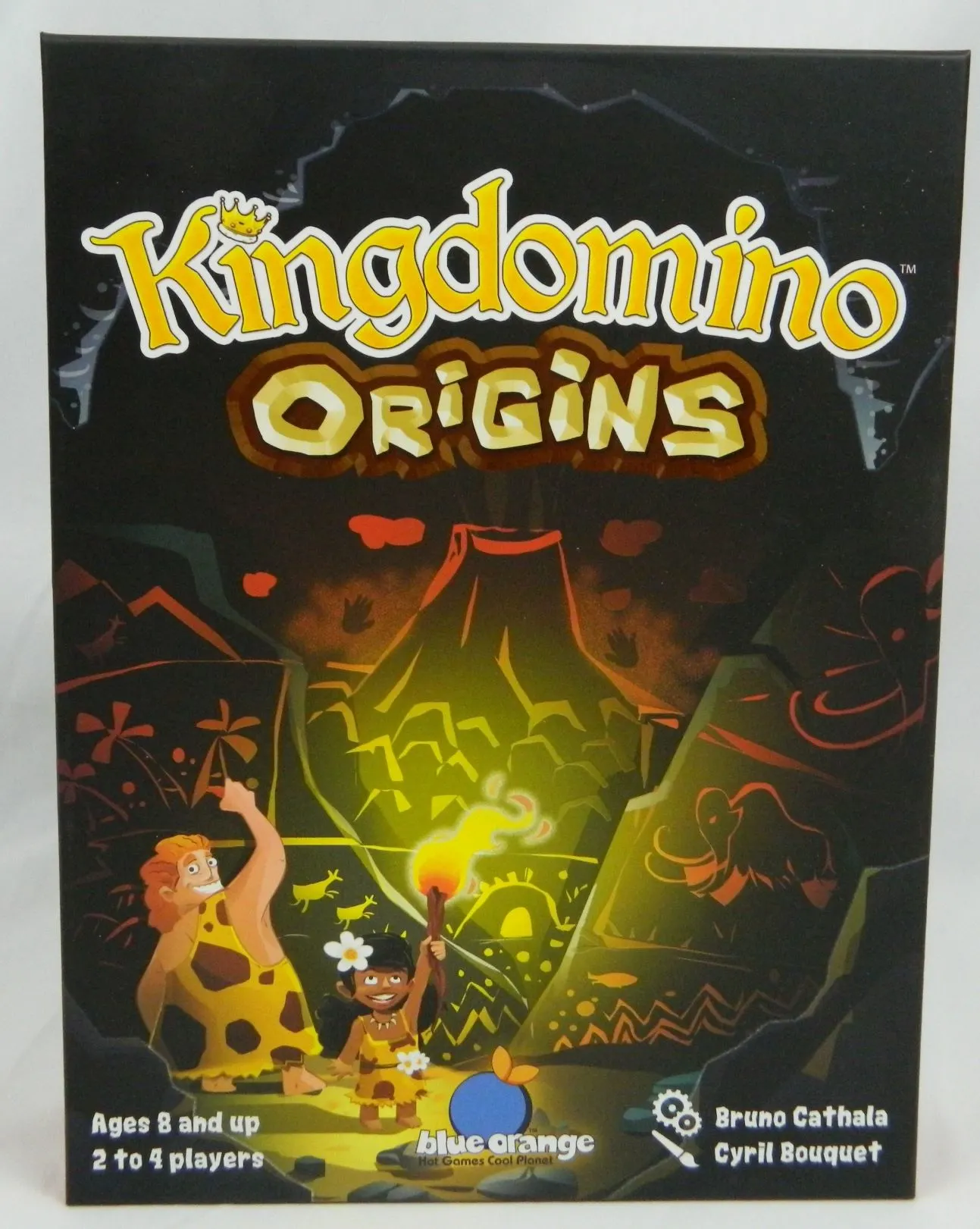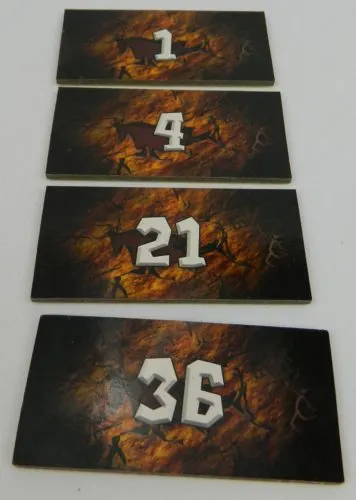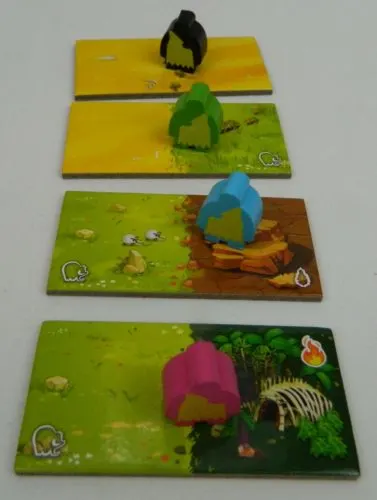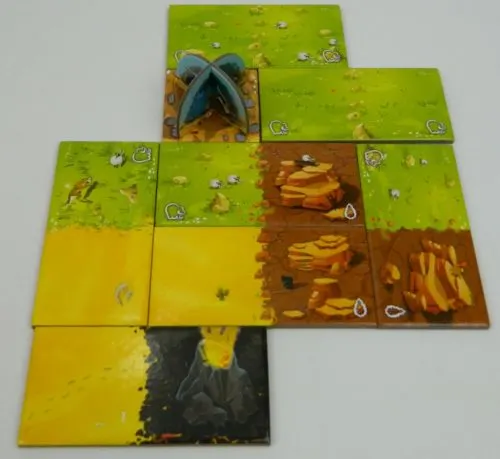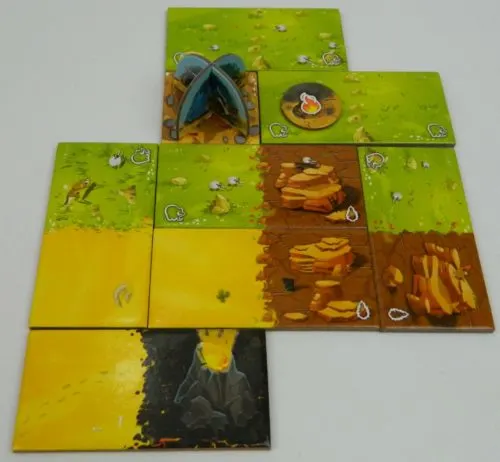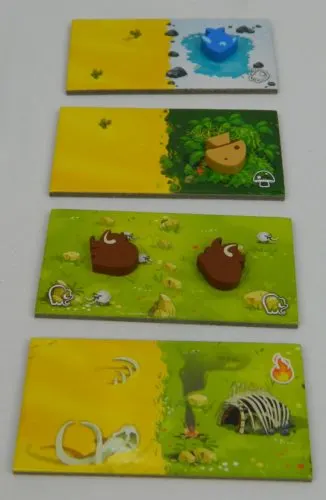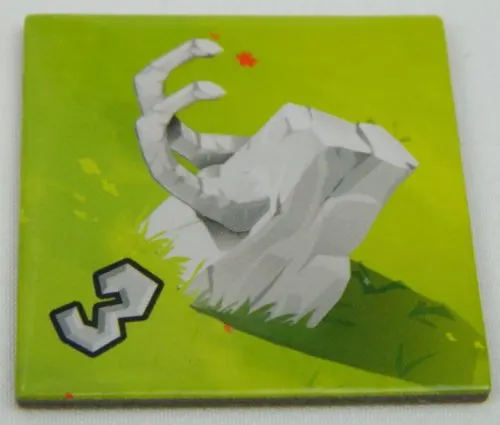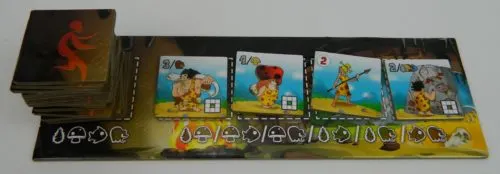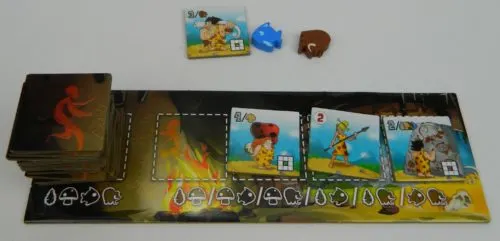Any regular reader of Geeky Hobbies will know that I am a big fan of the Kingdomino franchise. In fact the original game is easily in my top ten board games of all time which is impressive as I have played close to 1,000 games at this point. This is why I was excited when Blue Orange Games sent me the newest game in the series Kingdomino Origins. As a big fan of the franchise I had pretty big expectations for the game. Outside of the Cavemen/Cavewoman theme, I didn’t really know how the game would differ from the rest of the series, but I was excited to find out. Kingdomino Origins shares quite a bit in common with the original game, but it adds a number of fun and interesting twists to create its own experience that is really fun.
How to Play Kingdomino Origins
There are three different game modes that you can play in Kingdomino Origins. The basic gameplay remains the same between all three modes, but each mode has its own unique twists.
Discovery Mode
Setup
- Each player chooses a color and takes components corresponding to their chosen color:
- Starting tile and hut. The starting tile is placed in front of you with the hut placed on top of it.
- One tribe chief
- Shuffle the dominoes. After shuffling them place them face down in a pile in the box with the number side face up.
- Draw four tiles from the pile and sort them by number with the lowest number at the top. Once the tiles are sorted flip them over to the other side.
- Sort the fire tokens by their value and place them on the table.
- One player will take the tribe chief from each player and randomly selects one of them. The player who controls that tribe chief will place it on the tile that they prefer. The next tribe chief is chosen who will get to choose the tile they want. This continues until all of the players have chosen a tile. If there is a tile that was not chosen, that tile is discarded.
- Create a new set of four tiles following the setup used to sort the initial tiles.
Playing the Game
The playing order for each round is determined by the order of the tribe chiefs. The tribe chief on the top tile will go first and play will continue until all of the players have taken their turn. On a player’s turn they will take two actions.
Place Your Domino
You will begin your turn by removing your tribe chief from the tile you chose. You will then place the tile in your territory.
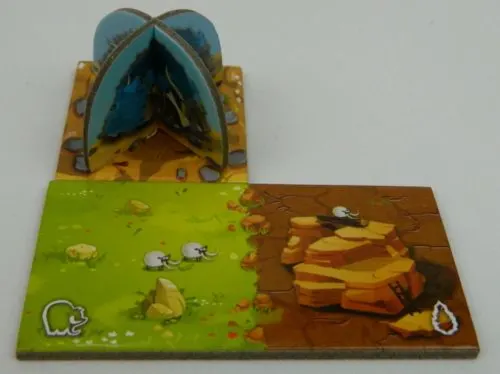
This player has placed the first tile into their territory. As their starting tile is wild, this tile could have been placed in any orientation as long as one side touched the first tile.
When placing a tile in your territory you must follow the corresponding placement rules:
- One of the two squares on the tile must touch another square of the same type horizontally or vertically. The starting tile is wild so any tile can be placed next to it.
- Your territory must never extend past a 5×5 square.
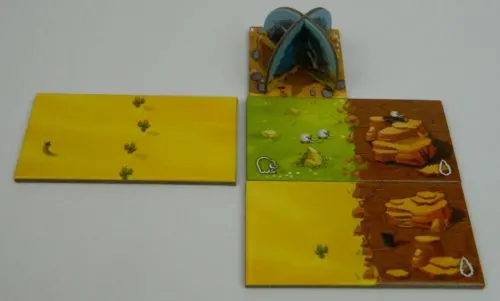
This picture shows two tiles being placed. The tile at the bottom was placed correctly as the quarry squares (brown) are connected. The tile on the left could not be played as it has a desert (yellow) placed next to a grassland (green).
If you can’t place your chosen tile due to these placement rules, you will discard the tile. If you can place the tile, you must place it even if it hurts you.
Choose A New Domino
After a player places their domino they will place their tribe chief on one of the tiles in the next group of four tiles. A player cannot chose a tile that already has a tribe chief on it.
End of Round
Once everyone has placed their tile and chosen a new tile, the next round can begin. Before the next round starts four new tiles are drawn and sorted based on their value.
The players will keep playing rounds until all of the tiles have been chosen.
Volcanoes
Some of the tiles in the game will feature a volcano on them. These volcanoes can feature one, two or three craters. When a player adds a tile that features a volcano to their territory they will take fire tokens based on the style of volcano pictured:
- 1 crater – Fire token with one fire that can be placed up to three spaces away from the volcano
- 2 craters – Fire token with two fires that can be placed up to two spaces away from the volcano
- 3 craters – Fire token with three fires that can be placed up to one space away from the volcano
The player will then choose a spot in their territory where the fire will land. The player will choose where to place the fire token by following these rules:
- A fire token can only be placed on an empty square without a fire token or fire symbol already on it.
- A fire token may not be placed on another volcano.
- A fire token can be placed on a square in any direction from the volcano up to the number of spaces allowed by the type of fire token. Fire tokens can be moved diagonally.
- This player has added a volcano to their territory. Since they placed the volcano tile this turn, they will immediately place a fire token on a space in their territory.
- As the placed volcano only has one crater they will place a one fire token up to three spaces away from the volcano. This player decided to place it on the grassland square as pictured. The fire was moved up two squares and diagonally one square.
If you cannot place a fire token due to these rules, the token will be returned to the box.
End of Game
When the last group of dominoes have been chosen and placed, the game ends. On each players’ last turn, they will only place their tile and not chose another tile.
Players will then tally their score based on how they placed their tiles. A player’s territory is divided into regions. A region consists of all of the squares that are touching one another (not diagonal) that are of the same terrain type.
Each region will be scored based on the number of squares in it multiplied by the number of fire symbols in the region (includes fire symbols printed on tiles and fire tokens).
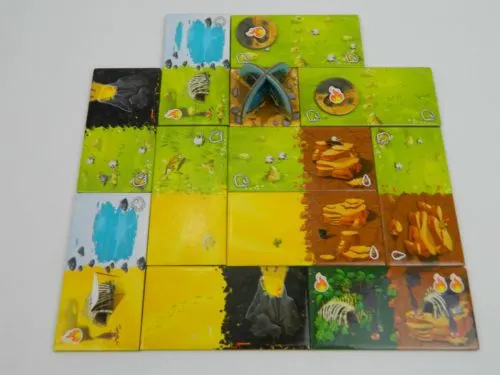
At the end of the game the players will score points as follows. The grassland region in the top right corner will score ten points (five squares x two fires). The bottom right quarry will score eight points (four squares x two fires). The jungle along the bottom will score one point (1×1). The desert in the bottom left corner will score four points (four squares x one fire). The grassland above the desert will score five points (five squares x one fire). The two lakes will score zero points as there are no fires in the region. The volcanoes will also not score any points.
Players will add up the points earned for each of the regions. The player that has scored the most total points will win the game.
If there is a tie, ties are broken with the following process:
- The tied player with the largest region (consisting of the most squares) wins.
- If there is still a tie, the player with the most fire symbols wins.
- If there is still a tie, the tied players share the victory.
Totem Mode
Totem Mode follows all of the rules of Discovery Mode. The additional rules for the mode are as follows.
Setup
After you have completed setup for Discovery Mode you will take these additional steps.
- Whenever tiles are flipped over in the game to create the next group of tiles, you will add wooden resource tokens to them based on their terrains. Each square that will receive a resource token has a symbol to indicate which resource it will receive. The resources that you will place on the terrains are as follows:
- Grassland – mammoth
- Lake – fish
- Jungle – mushroom
- Quarry – flint
- Deserts/Volcanoes – nothing
- Take the four totem tiles and place them in the center of the table where everyone can reach them.
Playing the Game
Whenever you place a new tile into your territory, you will count up the number of resources that you have of each type. If you have more of a type of resource than all of the other players, you will take the corresponding totem tile even if another player currently controls it.
If a fire token should ever be placed on a square that has a resource on it, the resource will be discarded. You should check to see if this impacted majorities and adjust the totem tiles as required. If you should lose majority of a resource, you will pass the Totem to the new majority leader. If there is a tie for majority, you will get to choose which tied player to give the totem to.
End of Game
Players will score points based on rules presented in the Discovery Mode.
Players will also be able to score additional bonus points based on the resources left on their tiles.
You will receive one point for each wooden resource token left on your tiles.
Players will tally how many of each resource they have to determine the majority for each type. The player with the most of each resource type will earn bonus points equal to the value printed on the corresponding totem tile.
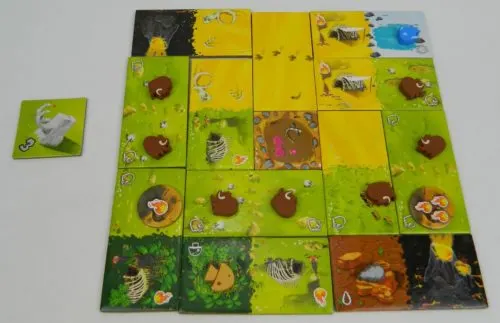
This player had the most mammoth resources so they control the mammoth totem which will score them three points. They will also score ten points from the wooden resource tokens left in their territory. In addition to these points the player will score points for the different regions they formed in their territory.
The player that scores the most total points between all of these different sources will win the game.
Tribe Mode
This mode utilizes all of the rules from the Discovery Mode. The mode also utilizes resources and Cavemen tiles.
Setup
- Follow the setup steps for Discovery Mode.
- Add wooden resources to each tile as noted in the Totem Mode setup.
- Position the Cave board above the line of dominoes. Shuffle the Cavemen tiles and place them in a face down stack on the Cave board. Flip over the top four tiles to fill in the spaces on the board.
Playing the Game
On each turn you will place a tile and choose a new tile following the rules of the Discovery Mode.
In the Tribe Mode you also have an optional action that you can take each turn. You can choose to recruit one of the face up Cavemen/Cavewomen on the Cave board. To recruit one of the face up tiles you will choose two different resource tokens from your gameboard and discard them. New Cavemen/Cavewomen tiles are only flipped over to replace missing tiles after all of the players have taken their turn in a round.
Otherwise you could choose to discard four different resources in order to look through the face down tiles and pick the tile that you want. Once you have picked a tile, you will shuffle the rest of the face down tiles and place them back on their spot on the Cave board.
After you have discarded the resources to acquire a tile, you will choose a square in your territory to place it on. A Caveman tile cannot be placed on any square that features a Fire Symbol, Fire Token, or a wooden resource. Otherwise you can place the Caveman/Cavewoman on any square even if you didn’t discard a resource from that spot to acquire the tile.
If a fire token should ever be placed on a square that you placed a Caveman/Cavewoman on, the tile will be discarded.
Cavemen/Cavewomen
The Cavemen/Cavewomen can be divided into two groups and will earn you points at the end of the game in different ways.
Hunter-gathers
Hunter-gathers will earn you points based on resources matching their specialty on the eight squares neighboring the square that it is placed on. Only wooden resource tokens will count for these abilities.
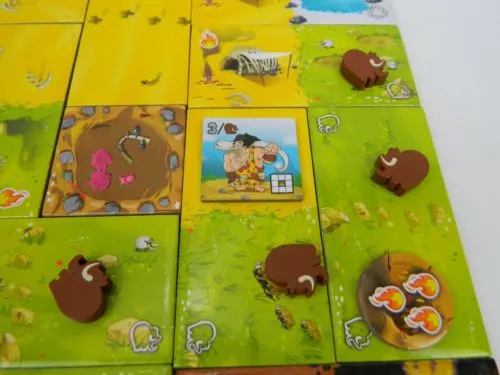
This player placed a hunter in their territory. They will score three points for each mammoth token on a neighboring space. As there are four mammoths on neighboring spaces, this hunter will score 12 points.
The Hunter – Scores three points for every mammoth on the neighboring eight spaces.
The Fishing Child – Scores three points for every fish on the neighboring eight spaces.
The Gatherer – Score four points for every mushroom on the neighboring eight spaces.
The Sculptor – Score five points for each flint on the neighboring eight spaces.
The Painter – Score two points for each resource of any type on the neighboring eight spaces.
The Fire Lady – Score one point for each fire symbol on the neighboring eight spaces.
Shaman – Score two points for each other Cavemen/Cavewoman tile on the neighboring eight spaces.
Warriors
Each warrior tile will have a number in the top left corner. This is how much the warrior is worth on its own.
At the end of the game each set of warriors that are connected to one another perpendicularly (not diagonally) will be scored together. You will count up all of the warrior numbers from a group and multiply the total by the number of warriors in the group to get the value of that group of warriors.
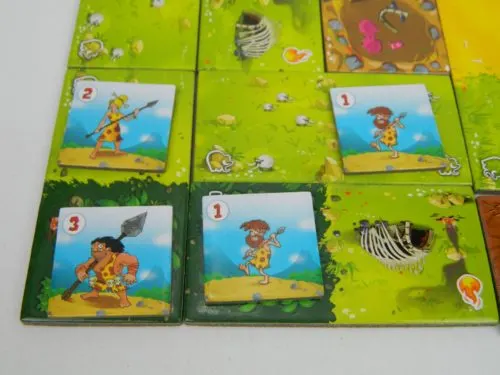
This player has created two groups of warriors. The warrior by itself is only worth one point (1×1). The other three warriors form a group with a total value of six. Multiplying the six by the three members of the group makes the group score 18 points.
End of Game
First you will score points based on the layout of your tiles as outlined in the Discovery Mode. You will then score points for any Cavemen/Cavewomen that you placed in your territory. You will not receive any points for the resources themselves that are left in your territory.
The player with the most total points wins the game.
Variant Rules
Some additional rules that you can choose to use in any of the modes are as follows:
Alternate Bonus Scoring
If your starting tile/hut is in the exact middle of your 5×5 territory, you will score ten bonus points.
If you were able to place all of your chosen tiles into your territory (you didn’t have to discard any tiles), you will receive five bonus points.
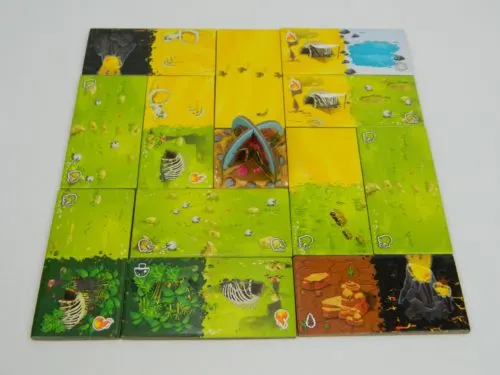
This player placed their hut/starting tile in the center of their 5×5 territory so they will score ten bonus points. They also used all of their tiles so they will score an additional five bonus points.
Two Player Games
If you are only playing with two players, a couple tweaks need to be made to the rules.
Setup
Each player will take two Tribe Chiefs of their chosen color.
Playing the Game
Players will make a 7×7 grid instead of the 5×5 grid of the normal game.
When choosing the tiles that you want, the first player to choose in a round will either pick the top and bottom tile or the second and third tile. The other player will get the other two tiles.
On your turn you will place both tiles into your territory and will select two tiles as detailed above.
My Thoughts on Kingdomino Origins
Based on the idea that Kingdomino Origins can be played in three different ways, I think the best way to look at the game is to look at each mode individually.
The simplest mode is Discovery Mode. This mode is very similar to the original game with only a few small tweaks. As I have already reviewed the original Kingdomino, I am not going to spend much time talking about what makes Kingdomino such a great game. I would recommend checking out my review of the original Kingdomino if you want more information about why the game’s gameplay framework works so well. Basically the game finds the perfect balance between simplicity and strategy. The game is quite easy to play especially if you have ever played a Dominoes style game before. Yet the game has quite a bit of strategy as you figure out what tiles to take and how to place them in your kingdom. All of these elements are present in Kingdomino Origins as it maintains everything that is so enjoyable about the original game.
There are two main differences between Discovery Mode and the original game. The more minor difference is that there is a slight difference in the distribution of the various types of terrain. The game seems to have made the different terrain types a little more even where there are more squares for the rarer terrain types and less squares of the most common types. The game has also ditched the mines/mountain terrain which featured a lot of crowns, and replaced them with volcanoes.
The volcanoes is where this mode and the game in general differs the most from the original Kingdomino. In the original game you tried to place tiles with crowns printed on them into each of your regions in order to score points. Kingdomino Origins has replaced the crowns with fire. Some tiles still have fire printed on them. Kingdomino Origins also lets you place fires out into your territory whenever you place a volcano. Each volcano will give you a fire token to place up to three squares away depending on the type of volcano that you place. Instead of just hoping to get tiles of the type that you need with crowns on them, the volcanoes give you some flexibility to move fires to the sections where you want them. While this is quite valuable, volcanoes otherwise are wasted spaces in your territory as they don’t score you any points themselves.
I found the volcanoes to be a really interesting addition to the game. In many ways they add more strategy to the game as they allow you the choice of where you want to put fire tokens. If you have a region that doesn’t already have a fire in it you can add that needed fire in order to score points. Otherwise you can add even more fire to a territory that already has some in order to increase your multiplier even further. There is some limitations on where you can place fire tokens, but generally they add quite a few options for your strategy. Because of this they can be quite powerful and thus when you choose one you will likely be towards the bottom in turn order for the next round. The volcanoes can also be kind of wasted if you receive them early in the game as your options for where to place the fire can be kind of limited. The volcanoes do add some complexity to the game, but also add more strategy to the game which more strategic players will appreciate.
I liked the addition of the volcanoes as I liked the additional element of having more flexibility in how you score. I do kind of miss the mountains/mines though as they can be great scoring opportunities if you could create a pretty large group of them. I am kind of on the fence on whether I prefer this or the original. Both games have their own merits and I really liked both of them. If you want a simpler game you may prefer the original game. Those who want more strategy will probably prefer the volcanoes. This is actually a key element of whether you will prefer the original game or Kingdomino Origins as it is probably the biggest difference between the two games. While the two games do share a lot in common, the addition of volcanoes does change the experience enough where I could see a reason to own both games.
Lets move onto the second game mode Totem Mode. Totem Mode is similar to the Discovery Mode except that it takes some of the resource mechanics from the Kingdomino print and play expansion “The Court“. The resources can earn you points in two ways. First each resource left in your territory at the end of the game will score you one point. The more valuable use of resources though is to have the most of one type as you will receive a bonus tile worth several points.
For those of you who never played with The Court expansion before, I liked a lot of things about it. What I liked the most about the addition of resources is that it did a good job making squares that otherwise weren’t that valuable on their own, a little more valuable. Some tiles/squares in Kingdomino are just more valuable than others. This is somewhat offset by worse tiles giving you a higher spot in turn order. That never felt like it entirely offset the fact that these tiles were weaker. The addition of resources helps close more of this gap as most squares will give you at least something that will help you.
In addition to scoring points by creating large sections with a lot of fire symbols in them, you are trying to focus on gathering a lot of resources of the same type in order to have the majority of that type. This adds an interesting majority control element to the game where you want to try and get one more resource of a type than the other players, but you don’t want to go overboard with one type as the resources are otherwise wasted. Just barely having enough of a resource to get the associated totem can be a key in the game as the couple additional points can be the difference between winning and losing the game.
Unless you want a simpler game, I see no reason not to play at least the Totem Mode. The game keeps all of the gameplay of the Discovery Mode and just adds one additional mechanic that adds a little more strategy to the game. It doesn’t even add all that much difficulty to the game. You have another thing to consider when you choose and place a tile, but this is easily offset by the fact that you have more strategic options. In a way though the Totem Mode feels like a stepping stone to the actual best mode in the game.
This brings me to the Tribe Mode. The Tribe Mode basically takes the Discovery Mode, adds in parts of the Totem Mode, and finally adds in another mechanic from The Court expansion. In this mode you will use the resources in two different ways. First you will use resources in order to recruit Cavemen/Cavewomen which will help out your territory. These tiles will be added to your territory and will give you additional ways of scoring points in the game. Most of them will score points if the associated resources are in a neighboring space. Others will score more points if they are placed next to one another in a large group.
In many ways this mode fully implements the majority of the mechanics introduced in The Court. Some of the tiles are different as the buildings have been replaced with warriors, but the concept is mostly the same. The mode allows you to use your resources in order to acquire tiles which you can add to your territory to score even more points. Along with creating large sections of the same terrain, these tiles can score you a lot of points if you place them in the perfect spot.
I will admit that the Cavemen/Cavewomen tiles do add some difficulty to the Discovery Mode, but the amount of strategy they add to the game is well worth it. While I could see playing each of the modes at times, of the three Tribe Mode is likely the one that I will end up playing the most. The reason I like this mode the most is just that it is the most strategic. Being able to add people tiles into your territory adds quite a bit of strategy and scoring opportunities. While you will still likely score most of your points through the regions you create, you can supplement this quite a bit with these tiles if placed in the right spots. They also add some interesting decisions to the game as you have to decide whether to use resources to acquire more Cavemen/Cavewomen tiles or keep them in your territory in order to score points from the tiles that you have already placed. In my review of The Court I mentioned that I hoped that Blue Orange Games would release a commercial version of the expansion. In a way Kingdomino Origins is that game with a few additional mechanics thrown in as well. I will definitely still play the original game, but I can see playing this mode just as much or even more than the original game.
Before wrapping up I wanted to quickly talk about the game’s components. The component quality of Kingdomino Origins is very comparable to the original game. Most of the components are made of cardboard, but they are thick where they will last. The game’s artwork is still fantastic. I have to bring up the addition of the resource tokens though. They are on the smaller side, but they are made of wood and look great. How could you not like the cute little mammoth tokens? As for the cavemen/cavewomen theme I would say that it is solid, but never plays a big role. The game could have probably used many other themes and not impacted the gameplay much as some parts of the gameplay feel a little stretched by the theme. The theme is still interesting though and the game’s components are fantastic.
Should You Buy Kingdomino Origins?
If I were to quickly describe Kingdomino Origins I would say that it feels like what you would get if you took the original game, added in the expansion The Court, and added a few more tweaks. In a lot of ways the game is similar to the original game. This is not a bad thing as the original game is fantastic, and the game maintains the great balance between simplicity and strategy. Probably the biggest addition to Kingdomino Origins is volcanoes which give you an opportunity to have some choice over where you place fires adding strategy to the game. This change may not be for everyone, but I think a lot of people will like the added strategy. Otherwise Kingdomino Origins implements a lot of the mechanics first introduced in The Court such as resources and tiles that you can be added to your territory in order to earn more points. I enjoyed these additions as they add to the game’s strategy. On top of all of this the game’s components are really good.
My recommendation for Kingdomino Origins is actually quite simple. If you have never really cared for the franchise, I don’t think Kingdomino Origins will change your mind. If you already own Kingdomino and the new mechanics don’t really interest you, I don’t know if it is worth also picking up Kingdomino Origins. If you enjoyed the original game though and are at least somewhat interested by the new mechanics, I think you will really enjoy Kingdomino Origins and should pick it up.
Buy Kingdomino Origins online: Amazon, Blue Orange Games
We would like to thank Blue Orange Games for the review copy of Kingdomino Origins used for this review. Other than receiving the review copy we at Geeky Hobbies received no other compensation. Receiving the review copy had no impact on the content of this review or the final score.

